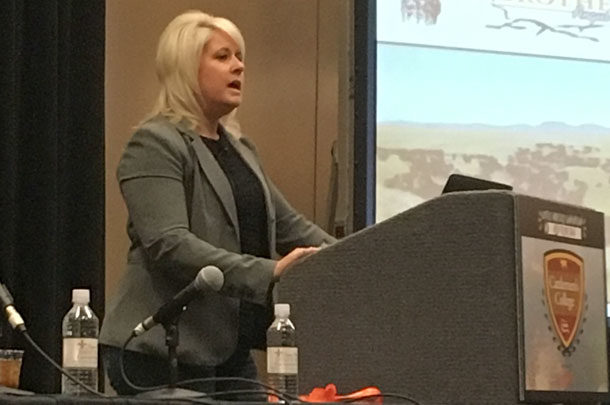Developmental programing
The theory behind developmental programming is based on the idea that what the cow eats and what she endures during her pregnancy can impact the lifetime performance of her calf.
Blair said that once the breeding decision has been made and conception has occurred, the animal’s genotype is set. From that point on, it’s up to producers to ensure that the environment can maximize that genotype that has been established in that animal. The phenotypes, or observable characteristics of an animal, are a 50-50 combination of an animal’s genotype and its environment. “But if we really think about some of the traits we’re interested in from a cattle production side of things, a lot of them are less than 50 percent heritable, and some of them are much less,” she said. “The role of the environment in this equation really can’t be overlooked.”
Timing matters
Block said the time of gestation in which a dam experiences dramatic changes to her diet or environment makes a difference in what is altered in the calf. Thanks to wide swings in forage quality and quantity throughout the year in any given region of the country, nutrient deficiencies at any stage of gestation are quite common. Heifers and young cows are at a higher risk for deficiencies due to their greater nutrient requirements.
“Also, although this area of research is fairly new, there is a growing body of evidence that points to influences on the offspring’s health, metabolism, immune status, feed efficiency, growth performance in the feedlot and ultimately meat quality,” Block said. “So regardless of where you’re at in the production chain, there is a potential influence on all these traits that you’re worried about.”
Block said there are critical windows of development where different processes are forming in the fetus that will change the way the fetus responds to treatments like restricting protein or energy. These processes include:
- Development of fetal organs: ~Day 20 of gestation
- Development of fetal sex organs: Day 50 to 60 of gestation
- Primary muscle fiber development: Day 0 to 90 of gestation
- Secondary muscle fiber development: Day 60 to 210 of gestation
- Muscle fiber growth: Day 150 of gestation to birth
- Fat cell development: Day 120 of gestation to birth
Early gestation
There are some things producers can do during early gestation (Day 0 to 90) that can potentially impact the reproduction capacity of female calves, especially follicle development and the establishment of a female’s reproductive organs.
The majority of placental growth is going to take place during the first half to two-thirds of gestation. Insufficient placental development results in reduced nutrient availability to the fetus, reduced flow of the umbilical vein to carry oxygen and reduction in growth factors that help the placenta function fully.
Mid-gestation
Mid-gestation is believed to be a key time point in regard to key traits such as feedlot performance and some measures of yield grade and quality grade.
Mid-gestation is a key developmental time point for both muscle and fat. Primary muscle fibers – formed in early gestation – form a scaffolding structure, which secondary muscle fibers build on or around. Secondary muscle fibers make up the bulk of the muscle mass of the animal. Secondary muscle fiber mass peaks in mid-gestation. “Any insult that might occur to mid-gestation could influence potential muscle mass for the rest of that animal’s life,” Blair said. “We can make them bigger, but we can’t ever get more.”
Blair said fat works a little differently. Fat cells are established earlier in gestation, but they continue to develop after birth. “Any insult that might occur can alter the establishment of these cells early and could also influence the distribution of these cells in the body of the animal postnatally.”
She said muscle and fat are important in the development of the fetus but can take the back seat in the event of a nutrient deficiency. “On the whole, [muscle and fat] rank pretty low in terms of importance to the developing fetus, so if nutrients are limited, priority is going to be given to those vital organs such as the brain, the heart and the lungs, and muscle and fat cell development could be compromised.”
Late gestation
Seventy-five percent of calf growth occurs in late gestation, since most of the fibers that have been developed during early and mid-gestation are now beginning to grow. This is a high production period for fat cells, so loss in nutrients or energy at this point of gestation could have a negative impact on intramuscular fat and brown fat, which helps calves maintain body temperature. An energy restriction at this point can increase death loss and result in decreased weaning weights.
Restrictions to energy or nutrition resources can also lead to lower body condition in the dam, making it more difficult for her to take care of her calf and breed back for the next production cycle. ![]()

-
Carrie Veselka
- Editor
- Progressive Cattleman
- Email Carrie Veselka
PHOTO: Dr. Amanda Blair led a study at South Dakota State University to learn more about how energy restrictions affect fetal development in mid-gestation. Photo by Carrie Veselka.









